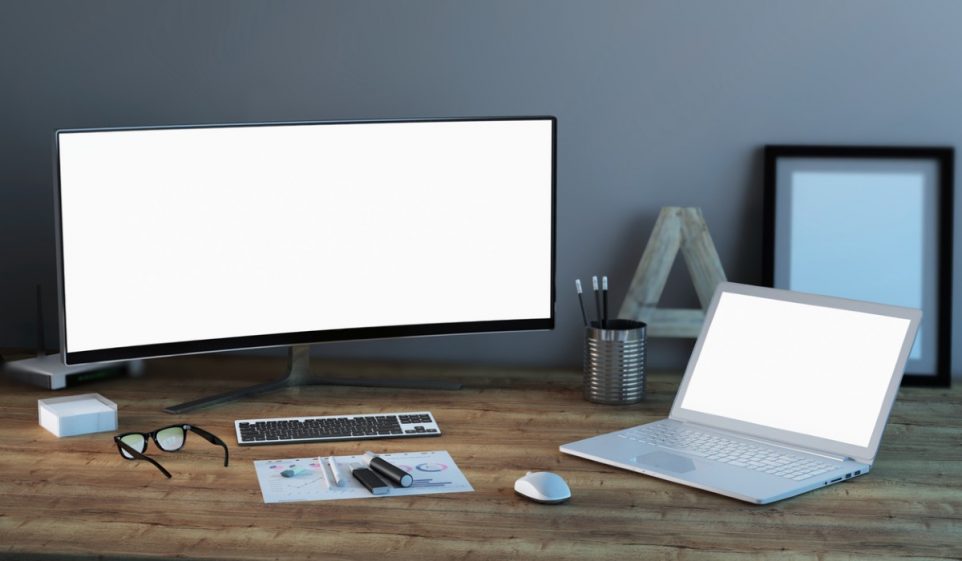The Debate Between Curved and Flat Monitors: Which Is the Better Option?

Gone are the days of bulky monitors, which were commonly used for gaming and work. Now, we have a wide range of monitors that come in many shapes and sizes and offer all sorts of functions. One of the long-standing points of disagreement among gamers and computer enthusiasts is the curved monitor vs. flat monitor debate. Both have their pros and cons, which is why we’re here to break down which one is right for you.
In this post, we’ll compare and contrast the features and specs of each type of monitor so you can make an informed choice. We’ll also provide an overview of different use cases for these monitors, helping you pick the perfect one based on your needs. So, read on for the ultimate guide to curved and flat monitors!
Pros and Cons of Curved Monitors
When it comes to curved monitors, several features make them stand out from their flat counterparts. For example, one of the main benefits is their increased field of view. Curved monitors offer a wider viewing angle than flat monitors due to their concave design, which can be incredibly useful for those who need to see a lot at once. Additionally, curved monitors typically come with higher resolutions than flat monitors, allowing for better image quality and clarity.
On the other hand, one of the downsides of curved monitors is that they take up more space on your desk due to their design. Additionally, depending on your setup, curved monitors can lead to distortion of text and images, which can be a problem if you’re working in design or other related fields.
Pros and Cons of Flat Monitors
Flat monitors are often considered less immersive than curved monitors due to their flat design. However, there are still several benefits associated with choosing one. One advantage is that they are generally more affordable than curved monitors and come with a lower price tag. Additionally, flat monitors tend to have faster response times because of their ability to quickly refresh image frames. This makes them ideal for gamers looking for a smooth gameplay experience without too much lag or blurring.
On the other hand, one downside of flat monitors is that since they don’t curve outwards as a curved monitor does, they don’t offer as wide of a viewing angle as their curved counterparts. They also don’t offer higher resolutions like curved monitors do, which may result in decreased sharpness or clarity when viewing images or videos, making them less suitable for multimedia purposes like video editing or gaming.
Factors To Consider When Deciding Between a Curved and Flat Monitor
When it comes time to decide between a curved or flat monitor, there are several factors you should take into consideration. First, it is important to think about what your needs are and how you plan on using your monitor on a daily basis. For example, if you need an immersive experience when playing video games or watching movies, then a curved monitor might be the better option since it offers a wider field of view than its flat counterpart does.
On the other hand, if swift response times are an important factor for you, then a flat monitor might be the better choice due to its fast refresh rate capabilities. Size and resolution are also important factors depending on what kind of projects or activities you plan on using your monitor for. Higher resolutions are typically available on curved monitors, while larger sizes are more commonly found among lower-resolution but flat models.
Use Cases for Curved and Flat Monitors
Now that we have discussed some of the pros and cons associated with each type of monitor, let’s take a look at some use cases where either option may be more beneficial than the other:
- For heavy multitasking or work that requires an increased field of view, such as coding or data analysis, you may want to consider getting a curved monitor due to its increased field of view and resolution capabilities.
- If you plan on mainly watching movies or playing video games, then opting for either one may depend largely on personal preference since both offer good image quality but differ in size and field of view.
- For general office work such as word processing and spreadsheets, a flat monitor might be best since it usually comes at a lower price point as well as offering faster response times.
Your Trust, Our Core Commitment
At Rising Tech, earning and maintaining your trust is the cornerstone of our mission. We're dedicated to transparency, impartiality, and the relentless pursuit of truth in every article, review, and recommendation we publish. Our commitment to these principles ensures that you, our valued reader, are always equipped with reliable and unbiased information. Let us be your trusted guide in the ever-evolving world of technology.